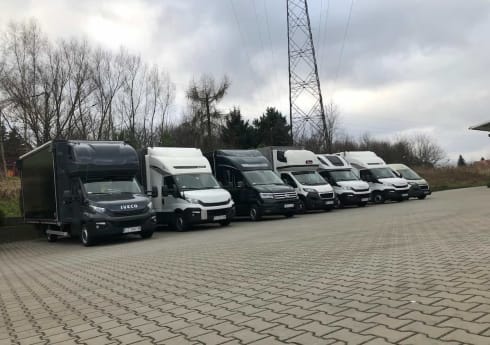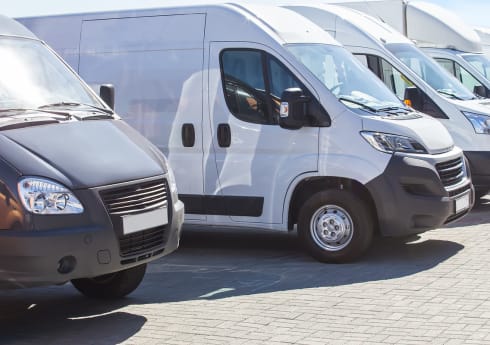10 Tips To Improve Fleet Efficiency Management
Improving fleet efficiency is key to reducing fuel costs and saving time. Having an efficient fleet is tough to achieve, but it’s made easier with good fleet telematics systems and vehicle tracking.
Follow these ten simple fleet efficient tips to get the most from your business vehicles and drivers in the safest, and most cost-effective way.

How to improve fleet efficiency
Fleet efficiency meaning lower costs and better outcomes is the elusive goal of every manager and owner.
How can you get fleet efficient? Using a fleet telematics system alongside dash cams and fuel cards is the best way to find out how your fleet can become more efficient. To get fleet fuel efficiency, you’ll need a system you can rely on and tools to back you up.
1. Use telematics software for efficient fleet management
Use fleet management software to cut down on your administration. One of the simplest ways to add fleet management to your business is by using account management software.
The benefit of using this software is that it cuts down on paperwork and makes it easier to keep on top of running your business.
2. Improve fleet fuel efficiency with fuel cards
One of the easiest and most cost-efficient ways of adding account management software to your business is by investing in fuel cards.
Fuel cards make buying fuel easier for your drivers, because they don’t have to carry around cash or worry about receipts. Even better, these cards help you get a fuel efficient fleet.
They typically come with account management software that simplifies business administrative tasks. For example, you can use the reporting tools to gain a complete overview of your fuel usage and spend.
You get detailed historical reports on fuel purchases, and usage by vehicle, driver or group. This can help you detect any inefficiencies in your business’ mobile workforce.
You can then make changes based on the data provided to ensure your business becomes more efficient, along with reducing your fuel bills.
iCompario tip: fuel cards for electric vehicles
Good efficient fleet management doesn’t go out the window when you switch to electric. While most fuel cards are for petrol or diesel, electric charge cards work just the same for all plug-in vehicles. The FleetOne REV can be used for petrol and electric, so hybrid vehicles in your fleet are covered no matter what.
3. Improve your vehicle fleet management with regular maintenance
Efficient fleet management means routine vehicle service and maintenance are essential for the longevity of your vehicles.
Regular inspections and continuous monitoring provide the tools that allow you to keep your vehicles at optimal performance. They also mean you can detect any issues before they become a costly problem.
By taking these preventative measures, you can reduce breakdowns, accidents caused by faults, and the time vehicles are out of commission.
4. Use Telematics to help preventative maintenance
Getting your vehicles serviced regularly is a great way to keep them running for longer.
But to get the maximum performance and lifespan from them, you should also use preventative maintenance.
Preventative maintenance is where you regularly perform checks on your vehicles, and equipment to reduce the chance of failures occurring.
Telematics is a powerful monitoring tool, which can assist in preventative maintenance. It does so by keeping track of the fuel consumption, mileage, and active engine hours of your vehicle. This provides actionable data to help reduce fuel consumption, improve driver behaviour, and reduce incidents of unauthorised vehicle use.
iCompario tip: you need telematics to be fleet efficient
Telematics gives a bird’s eye view of your fleet. It’s never been easier to manage all your drivers. You can deal with breakdowns or accidents immediately and even check the driver dashcam footage or speeding incidents from your mobile phone.
5. Improve driver performance
You can optimise your vehicles and software till the cows come home, but unless you optimise your drivers, you’ll never have a good fleet efficiency level.
One of the many great benefits of using telematics to help manage your fleet is that it allows you to monitor how your employees are performing.
You can monitor when equipment is running and performing billable hours, or when vehicles and employees arrived/left a job, helping you manage overtime requests and potentially saving money on unnecessary labour costs.
While all drivers should be held to high-performance standards, bad habits can sometimes creep in and be hard to combat.
Once you’ve installed a telematics box or have been monitoring the data recorded via your fuel card account management software, you may notice some inefficiencies in driver behaviour.
6. Use training & incentives to manage your fleet drivers
Your drivers are one of the most important parts of your business. No matter how well you manage and maintain your fleet vehicles, if the people behind the wheel aren’t operating at their best then your business will be losing money.
There are two methods you can use to get the most from your drivers – training and incentives.
Training sessions should be recurring for all drivers, new and experienced, to keep them fresh on best driving practices and regulations.
Incentivising drivers for doing a good job, such as achieving high fuel efficiency, performing vehicle ins regularly, or exhibiting high driving performance will increase the lifecycle of vehicles and reduce maintenance fees in the long run. It will also mean that you have a safer fleet with reduced fuel costs.
7. Run fewer vehicles at full capacity to have higher fleet efficiency
Fuel efficient fleet trucks are hard to get! Smaller vehicles are more fuel efficient. It makes much more economic sense to run fewer vehicles at full capacity, rather than multiple vehicles at half capacity. The cost of running one smaller, full vehicle is less than the cost of a larger, half-full vehicle.
If you do you use trucks, get truck fuel cards to see how much fuel you’re using and find out how you can cut down.
8. Manage your fleet’s time better by planning out your journeys
One of the biggest threats to a business’ profits is resources being used inefficiently.
For businesses that rely on transport, failing to plan out journeys in advance is one of the obvious ways that you can make sure your resources (drivers, fuel, and vehicles) are being used efficiently.
While on a job, planning return routes avoids empty trucks using fuel without purpose and increases the productivity of your fleet.
9. Keep track of service times for rental vehicles
When we think about fleet efficiency rentals are important too. If you have any hired business vehicles, make sure you add their service history and next appointments to your calendar.
Some rentals can provide service appointments for you and will send notifications to keep you in the know. This can be easier to manage things if you have multiple vehicles for hire, especially if they have different service dates.
10. Get dash cams to check on your vehicles
Dash cams improve fleet efficiency in ways you wouldn’t expect. You can get rear facing cameras to check on driver’s behaviour.
Many fleet managers have noticed poor driver performance on their management system, only to draw a blank for the cause of it. But checking the camera can show you the reason why. Sometimes its drivers on their phones or smoking instead of paying attention to the road.
Making and defending against insurance claims is also easier when you have a video camera system. You’ve always got the evidence to back you up.
Use Telematics to help preventative maintenance
Getting your vehicles serviced regularly is a great way to keep them running for longer.
But to get the maximum performance and lifespan from them, you should also use preventative maintenance.
Preventative maintenance is where you regularly perform checks on your vehicles, and equipment to reduce the chance of failures occurring.
Telematics is a powerful monitoring tool, which can assist in preventative maintenance. It does so by keeping track of the fuel consumption, mileage, and active engine hours of your vehicle. This provides actionable data to help reduce fuel consumption, improve driver behaviour, and reduce incidents of unauthorised vehicle use.
No matter how many vehicles your business operates, combining all of these tips and pieces of advice will ensure a smooth-running, efficient business.
How to have a fuel efficient fleet
Having an efficient fleet won’t happen overnight, even if you have the best fleet management system money can buy. The important thing is to keep your eye on the prize and do regular checks on your vehicles, drivers and telematics system. Need a system up for the job? Compare fleet systems and find a custom, flexible setup to best fit what you need.



